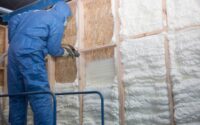Many symptoms will appear if you or someone you care about has been exposed to mold. While they are apparent, they frequently go unnoticed since they are similar to health concerns that aren’t as dangerous as the common cold or flu. Naturally, any recurring health issue is usually a symptom of a more severe problem; in this situation, it could indicate that you have a mold infestation in your home.
Mold Exposure Symptoms
Mold-related health problems can be divided into four categories: allergic reactions, infections, irritating effects, and toxic effects. Anecdotal data suggests that mold poisoning can result from ingesting mold-tainted food. Despite this, many people are still confused about the subject. So now, let’s look at some of the most common mold symptoms that point to mold exposure or a moldy environment:
1. Allergic Reactions
Mold exposure can cause various symptoms, including allergic reactions. This is a condition that occurs in persons who have been exposed to mold in any form.
Mold spores can be ingested, inhaled, or even touched. Single or repeated exposure to an allergen might trigger an allergic reaction in certain people.
Mold exposure can make people who aren’t normally sensitive become sensitive, and repeated exposure can make people more susceptible.
An average mold-sensitive person’s mold allergy symptoms include the following:
- Headache
- a stuffy or runny nose
- A sudden sense of congestion
- Watery, red, or itchy eyes
- Dermatitis, often known as a skin rash
- Sneezing
- Wheezing
Mold symptoms, such as shortness of breath, are similar to hay fever in people with severe allergies.
Significant mold levels are more likely to cause severe allergic reactions in workers in places where mold is a problem, such as farms and retail stores.
2. Asthma Attacks
When molds are present in a person’s environment, they can worsen an asthma attack or raise the possibility of an asthma attack. Mold can trigger severe allergic reactions in those who have asthma.
Even in children who are not genetically prone to asthma, early mold exposure has been shown to increase the danger of developing the condition.
3. Irritating Substances
Mold, mold spores, and mold fragments can irritate the eyes, nose, throat, and lungs when breathed in. Occasionally, mold can cause unpleasant skin disorders like rashes because of mold exposure. As a result, you can have:
- Nasal irritation
- Skin burning
4. Other Health Problems
Upper Respiratory Tract Symptoms
- The Institute of Medicine concludes that there is sufficient evidence linking mold exposure to upper respiratory tract symptoms such as wheezing and coughing.
Hypersensitivity Pneumonitis
- Long-term mold exposure may raise the risk of hypersensitivity pneumonitis in persons who are already at risk of developing this immune-mediated illness. Unlike bacterial pneumonia, hypersensitivity pneumonitis occurs in a small number of people.
Opportunistic Infections
- If you have a compromised immune system, inhaling mold spores can lead to some other infections that are more difficult to treat.
What must you do if you see mold symptoms?
The golden rule is to always pay attention to your body’s signs. The presence of a musty odor and one or more mold symptoms is a strong indicator of a problem with mold in the home. Generally, you can use one of the do-it-yourself mold removal methods if the contaminated area is only a small one. To learn more about mold cleaning check out restoration cleaning in Akron.
Suppose you notice a significant amount of mold development in your building and are experiencing any mold-related symptoms. In that case, the professional fast mold cleaning services can check your house thoroughly and recommend the best course of action.
Your health suffers because of mold, and medical treatment isn’t helping. If this is the case, it may be necessary to get mold remediation done. A mold inspection by a trained mold inspector may be beneficial.








